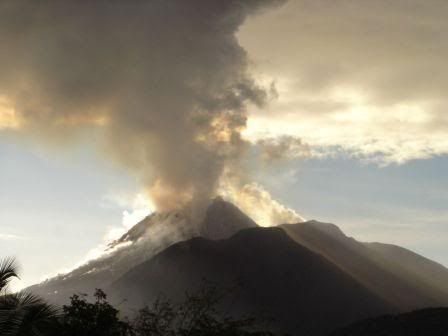The Pipsqueak Human Contribution To Global Warming
 This volcano, the Soufrière Hills Volcano on the Carribean island of Monserrat, has been erupting since July 18, 1985 -- 22 years ago. It's been erupting for five months longer than Incredible Daughter #1 has been breathing!
This volcano, the Soufrière Hills Volcano on the Carribean island of Monserrat, has been erupting since July 18, 1985 -- 22 years ago. It's been erupting for five months longer than Incredible Daughter #1 has been breathing!Even after all this time, the volcano is still kicking climate change butt: It is spitting out sulphur dioxide (SO2) at a rate of 110 tons per day to 217 tons per day, with an average of 150 tons. That's pretty awful, but it's well below the long-term average for the eruption, which remains around 500 tons per day.
What does that mean for climate change? Here's a USGS explanation, which I've simplified a bit:
The Soufreier Hills volcano is pretty much a baby in the global volcano scheme. These things have been blowing for millenia, both warming and cooling the atmosphere, creating ozone holes and acid rain.Large, explosive volcanic eruptions inject water vapor, carbon dioxide, sulfur dioxide, ash and other chemicals into the stratosphere to heights of 10-20 miles above the Earth's surface. The most significant impacts from these injections come from the conversion of sulfur dioxide to sulfuric acid, which condenses rapidly in the stratosphere to form fine sulfate aerosols.
The aerosols increase the reflection of radiation from the Sun back into space and thus cool the Earth's lower atmosphere or troposphere; however, they also absorb heat radiated up from the Earth, thereby warming the stratosphere. Several eruptions during the past century have caused a decline in the average temperature at the Earth's surface of up to half a degree (Fahrenheit scale) for periods of one to three years.
The sulfate aerosols also promote complex chemical reactions on their surfaces that alter chlorine and nitrogen chemical species in the stratosphere. This effect, together with increased stratospheric chlorine levels from chlorofluorocarbon pollution, generates chlorine monoxide, which destroys ozone. As the aerosols grow and coagulate, they settle down into the upper troposphere where they serve as nuclei for cirrus clouds and further modify the Earth's radiation balance.
Finally, explosive volcanic eruptions release the greenhouse gas carbon dioxide and thus provide a deep source of carbon for biogeochemical cycles.
And the Warmies look at our puny SUVs and see doom. I'm sorry. Model as they will to point the big guilty finger of doom at humans, it is obvious that much, much larger forces -- from solar flares, volcanic flare-ups and the incredible hugeness of water vapor -- make our puny contributions to greenhouse gases a pittance.
Labels: Climate change, Global warming




<< Home